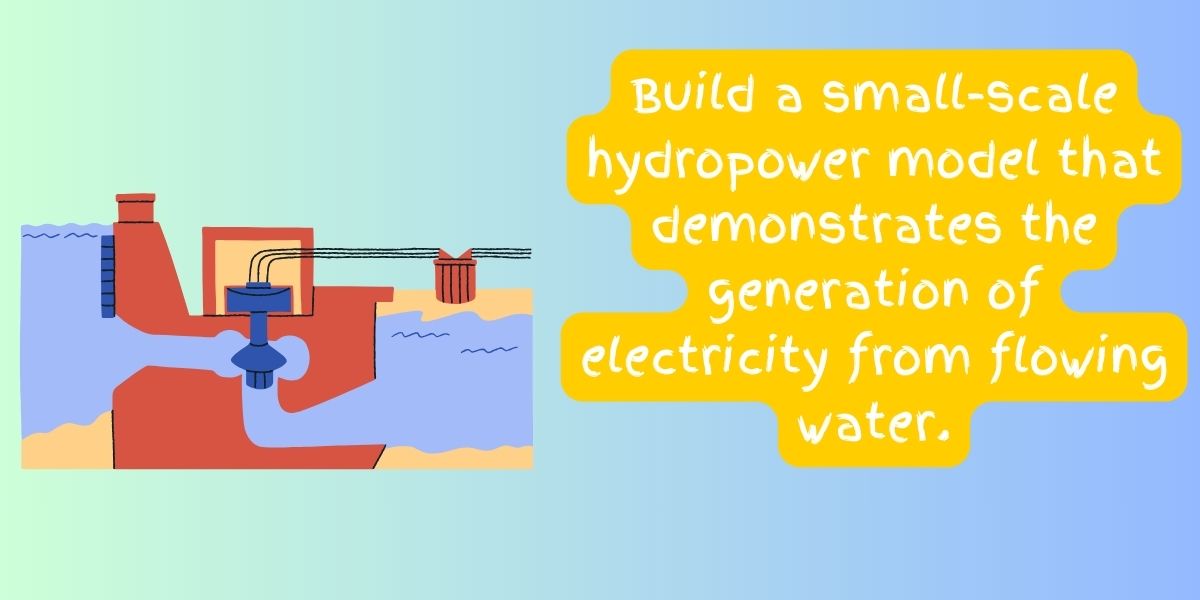To design and build a small-scale hydropower model demonstrating the generation of electricity from flowing water, we’ll create a simple setup using easily accessible materials. Here’s a step-by-step guide:
Materials Needed:
- Plastic container or bucket (to act as a water reservoir)
- Small water pump (submersible pump or aquarium pump)
- Plastic tubing or PVC pipe
- Waterwheel or turbine (can be homemade using plastic cups, spoons, or cardboard)
- DC motor or small generator
- LED light bulb or small electronic device (to demonstrate electricity generation)
- Wires and alligator clips
- Hot glue gun or waterproof adhesive
- Scissors or utility knife
- Water source (such as a faucet or water bottle)
Steps:
- Prepare the Water Reservoir:
- Fill the plastic container or bucket with water. This will act as your water reservoir.
- Install the Water Pump:
- Submerge the water pump in the water reservoir. Ensure that the pump is fully submerged and securely positioned at the bottom of the reservoir.
- Connect the Tubing:
- Attach one end of the plastic tubing or PVC pipe to the outlet of the water pump.
- Run the tubing from the water pump to the location where you will install the waterwheel or turbine.
- Construct the Waterwheel or Turbine:
- Create a simple waterwheel or turbine using materials like plastic cups, spoons, or cardboard. Cut and shape the materials to form the blades of the waterwheel or turbine.
- Attach the waterwheel or turbine to a shaft or axle. Ensure that it can rotate freely when water flows through it.
- Connect the Waterwheel to the DC Motor or Generator:
- Position the DC motor or generator adjacent to the waterwheel or turbine.
- Connect the shaft or axle of the waterwheel to the shaft of the DC motor or generator using a coupling or direct connection.
- Test the Setup:
- Turn on the water pump to start the flow of water through the tubing.
- Observe the rotation of the waterwheel or turbine as water flows over it.
- Check if the DC motor or generator generates electricity when the waterwheel rotates. You can test this by connecting the motor or generator to an LED light bulb or small electronic device.
- Secure and Adjust:
- Use hot glue gun or waterproof adhesive to secure all components in place. Ensure that the tubing, waterwheel, and motor/generator are securely attached and aligned properly.
- Make any necessary adjustments to optimize the performance of the hydropower model.
- Demonstrate Electricity Generation:
- Once the setup is optimized and functional, demonstrate the generation of electricity by turning on the water pump and observing the LED light bulb or small electronic device powered by the DC motor or generator.
This small-scale hydropower model provides a hands-on demonstration of how flowing water can be used to generate electricity. It helps students understand the principles of hydropower and its potential applications for renewable energy generation.
Importance of Hydropower:
- Renewable Energy Source: Hydropower harnesses the energy of flowing water to generate electricity without depleting finite resources like fossil fuels.
- Environmental Sustainability: Hydropower produces minimal greenhouse gas emissions and helps reduce reliance on polluting energy sources.
- Reliable Power Generation: Hydropower plants can provide consistent and reliable electricity, contributing to energy security and grid stability.
- Water Management: Hydropower projects often involve reservoirs and water management systems that can help regulate water flow, prevent floods, and support irrigation.
- Economic Benefits: Hydropower projects create jobs, stimulate economic development, and provide revenue for local communities and governments.
Applications of Hydropower:
- Electricity Generation: Hydropower plants produce electricity for residential, commercial, and industrial use.
- Water Supply: Some hydropower systems also serve as water supply sources for drinking water, irrigation, and industrial processes.
- Flood Control: Hydropower reservoirs can help regulate water levels and mitigate the risk of floods in downstream areas.
- Recreation: Hydropower reservoirs and surrounding areas offer opportunities for recreational activities such as boating, fishing, and camping.
- Environmental Management: Hydropower projects support environmental conservation efforts by preserving natural habitats and promoting sustainable water use.


No responses yet